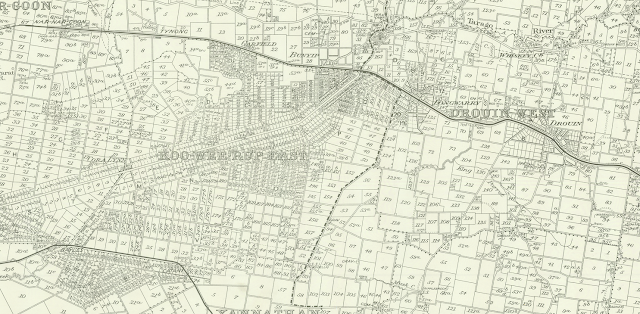As early as 1897 the Village Settlers on the Koo Wee Rup Swamp began agitating to have their area secede from the Shire of Berwick and become part of the Shire of Buln Buln (1). The settlers felt that they had more in common with the Buln Buln Shire. As well, Drouin, where the Buln Buln Shire Offices were located was closer the the settlers than the Shire of Berwick Offices at Berwick and the Buln Buln Shire had cheaper rates. One report said that nine-tenths of the settlers preferred Buln Buln to Berwick (2).
Some of the settlers thought they were already in the Buln Buln Shire as the boundary was the Bunyip River. The South Bourke and Mornington Journal reported that up to quite recently it was understood by the Buln Buln council that the Bunyip River was the boundary, which of course, means the main drain; but it was quietly shifted to the parish and county boundary some time ago without the knowledge of the last-named council (3), The main drain was the canalised section of the Bunyip River, which was dug between 1889 and 1893, the scheme having been engineered by William Thwaites of the Public Works Department.
To further their case, in August 1899 a deputation consisting of Messrs Leithhead, M'Namara, and Hill, representing the South Bunyip settlers, waited on the Public Works department, and in the course of a conversation with Mr. Catani, the engineer to the department, that gentleman advised them to apply to be annexed to a shire, as it would be greatly to their advantage. It was also suggested that the whole of the parish of Koo-wee-rup East could join Buln Buln Shire as new territory under section 46 of the Local Government Act, which gives the Governor in Council power to make orders for re-adjustment of boundaries of adjacent shires without any petition (4).
This was important advice from Carlo because the settlers had an unusual problem. The Shire of Berwick had not yet began to levy rates on the settlers and under the Local Government Act only rate payers could petition for severance or annexation (5).
The newspaper report continued - Mr. Hill said that Mr. Catani stated that beyond the usual votes for roads to village settlements the Government would not do anything to the roads until the settlers became annexed to a shire. Any money voted for drainage works would be laid out at once....but any further monies for the road would have to be spent under the supervision of a shire council, which could get better value for work done than the department got. There was a lengthy conversation on this subject, and the speaker [Mr Hill] said that Mr. Catani appeared to think that it would be better for them to join the Buln Buln shire than allow Berwick to absorb them. The former being a fifth class shire got a subsidy on a higher scale, and the annual rate was also less. . . He pointed out that it was absolutely necessary to take steps that night, and appoint a deputation to interview the Buln Buln council the following day, and the initiative taken this month. He urged that the Berwick shire was making arrangements to rate the Swamp areas, and if once rated, a number of vexatious formalities would have to be gone through before they could be severed from Berwick and annexed to Buln Buln (6).
It's not like me to criticise Carlo at all, but he was wrong on one fact - both Buln Buln and Berwick were both the same level of Shire - they were both in the second class (7).
The next month, September 1899, a deputation of settlers also met the Secretary for Public Works, Mr Martin who advised that the easiest way for the desired result to eventuate was for the the Berwick Shire to agree to severance and Buln Buln to agree to annexation (8). In the same month, Mr Hill addressed a meeting of the Shire of Berwick. He did not get their support as the President moved that in view of the increased value land in the Koo-wee-rup East district it was not advisable that that portion of the shire should secede, and the request of the settlers be not granted; and suggested that the whole of the swamp area form a separate riding of the Shire of Berwick. - Seconded by Cr. a'Beckett and carried (9).
The issue surfaced occasionally in 1900, but it was not until 1901 when any hopes the settlers had of being annexed to Buln Buln were dashed. On May 31, 1901 the Iona Riding of the Shire of Berwick came into being which covered the entire Swamp area of the Shire (10). One of the settler's objections, that of the Shire Offices being too far away at Berwick, was also addressed, as from March 1902 all Council meetings were held in Pakenham, a more central location (11).
Koo Wee Rup Swamp History - I have another blog devoted to the history of the Koo Wee Rup Swamp, https://kooweerupswamphistory.blogspot.com/
Trove list - I have created a list of articles on this subject on Trove, access it here.
Footnotes(1) Warragul Guardian, November 30 1897, see here.
(2) South Bourke & Mornington Journal, March 22 1899, see here.
(3) South Bourke & Mornington Journal, March 22 1899, see here.


No comments:
Post a Comment